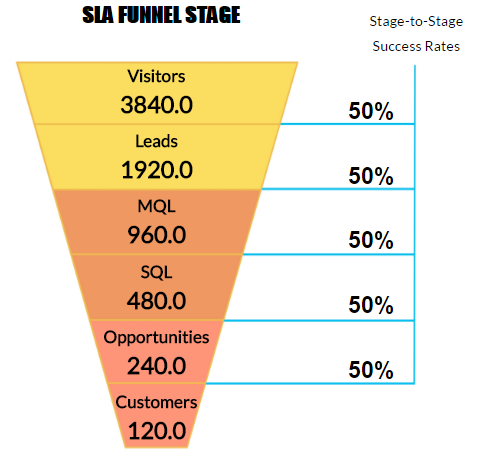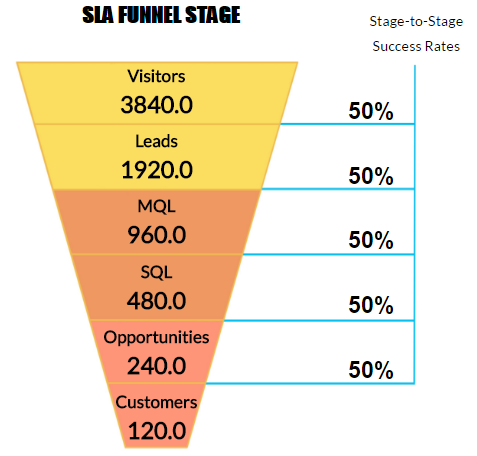Learn How to Use an SLA to Get Sales and Marketing on the Same Sheet of Music
You've no doubt read the statistics on business failure. Not many new businesses last beyond the five year point. Fewer still make it to the ten year mark.

Glad to say we've just recently passed that magic point. That means, though still small, we've been making payroll every month for 14 years. It is all automated now, but believe me, when I started out, I didn't have my Business Operating System (BOS) built.
But I Did Have a Technical Model To Go On
You see, before I started my SAP consultancy, I had worked for many, many years as a Senior Industry Principal for SAP. I had Sales and Marketing responsibility for several key industries, including:
- Professional Services.
- Retail.
- Logistics.
- Aerospace & Defense.
- Postal.
- Engineering Construction & Operations (ECO).
- Rail.
Though I came from a hard-core military logistics background, specifically, aircraft maintenance, SAP had steadily provided me with Advanced Sales Training over the years. With the Industry Principal hat, I had responsibility for what many might consider a significant sales pipeline. I also had access to advanced measurement tools, which I used extensively. The primary one being the SAP Business Warehouse. In addition, I had the services of a fairly large marketing department, which operated on a shared services basis.
Defined Performance Metrics
You should know that I am also a SAP Certified Materials Management Consultant, as well as SAP Project Manager (and hold many other SAP Certifications). In all of these roles, there had always been well defined performance metrics. They came down to get it live and make it work at a profit. I also hold or have held 13 different Hubspot marketing and sales certifications. Holding these certificates helps us maintain our hubspot-reseller-agreement, which is great motivation for maintaining them.
Multiple SAP Industry Principal Certifications
In addition, for each of those industries I had responsibility for, I had taken internal SAP Industry Principal training and certification courses. So I knew how my industries operated, across all Lines of Business' (LOB). This knowledge was especially useful when I designed my BOS before launching.
Each Business Had Quasi Dedicated Marketing and Sales Departments
While SAP was very large then and is much larger now, it was still resource constrained, as I imagine just about every large enterprise is. As an quota carrying industry principal, working in a regional office, in this case, the Middle East and North Africa (MENA) office based out of dubai, I reported to the local head of sales.
Industry Go-to-Market Product Strategy
Every piece of software sold by SAP has an internal owner, as well as an associated product marketing owner. While a great deal of effort is made to ensure consistent, on-brand messaging across industry verticals, the content and quality can vary considerably.
The practical consequence of this arrangement, from the field level, is that you end up dealing with multiple sales and marketing departments. It all works, but your network is your superpower.
SAP Professional Services Served as Baseline Business Process Model
The most useful business model, from a consulting services delivery standpoint, was the SAP Professional Services Industry Solution. Over the years, the hard-stuff, like time-and-expenses, which used to be the bane of consultants the world over, had largely been automated.
Scotch Tape Your Receipts to White Sheet of Paper
For example, when I first started submitting expense reports, the finance department insisted that we scotch tape all receipts to a piece of white-paper, before they would accept it and reimburse us. Some would insist they be in date order. Others would not accept hand written receipts (the only type available in many countries). These days, it is entirely possible to do it all online, never touch a receipt, and have it direct deposited in your account.
Preparing The Dreaded Annual Business Plan
Each year, as in almost every successful business, I had to submit a business plan to SAP corporate. In my role as SAP Industry Principal, I had responsibility for and support from all the elements of the business, including the marketing and sales department, Consulting, Training, Development, Pre-Sales and others.
Committing to the Business Plan
The business planning exercise, to be totally honest, was painful to do. Or at least do honestly, and commit to it. By commit, I mean, sign-off on the software license revenue I was going to generate for the company.
Sales Forecasting Accurately is Paramount
As SAP was a publicly traded company, their ability to forecast accurately was fairly important. It also could play havoc on Revenue Recognition if you couldn't back up your forecast.
I Also had SAP Business Partners I Needed to Work With
When you work in a large organization, such as SAP, you work as part of a gigantic, global eco-system. About 80% of the SAP software sales are actually done by an army of SAP Partners.
Service Commitment to SAP Partners
In my case, I routinely worked with 59 SAP Partners.

From Annual Business Plan to Service Level Agreement (SLA) Numbers
Each partner, just like myself, needed to submit a business plan to SAP. As you might imagine, many balked, while others did a good job on it.

Why SAP Partners Wanted the SAL in Place
But why would a partner, who, in reality, is an external service provider to SAP in many scenarios, need or want to submit a business plan to SAP?
SAP Established Service Level Agreements With SAP Partners
The partner business plan was, in reality, the foundation for SLA's between SAP and their partners. You see, SAP invests a lot of money in marketing, and many of those marketing efforts generate leads that get passed onto the SAP Partners.
Partner Key Performance Indicators
While we spent a great deal of money generating leads, we spent an even greater sum establishing KPIs (Key Performance Indicators) between SAP and SAP Partners.
Establish a Hierarchy of KPIs
There were top level indicators, such as Partner driven revenue, and several supporting metrics, such time taken to respond to a lead (if they respond at all) passed by SAP to the partner.
KPIs Should Have Measurable Goals
While establishing a mutually agreed upon SLA is a prerequisite for success, and having a hierarchy of KPIs that both sides agree to adhere to is important, it is even more critical to establish measurable goals.
From Measurable Goals to Actionable Objectives
If having goals is important, you are unlikely to achieve success unless design objectives that can worked on and met by both parties. That's why I was delivering those weekly webinars to those 59 SAP Partners. It was part of our established commitment to our partners to provide a continuous stream of educational content on the SAP Product. In my case, I leaned heavily on product marketing to prepare and deliver these educational webinars.
Actionable Objectives Drove Appropriate Behavior
Naturally enough, the actions that both parties to the SLA agreed to within the partner agreement were designed to drive the appropriate behavior. In this case, there were expectations on both SAP and the SAP Partners.
For example, different partners were expected to have a certain number of certified consultants on staff. From the SAP side, SAP was expected to spend enough on marketing to generate a predetermined number of leads, which were then fed to the partners.
Different Types of SLA Magic Tricks
I've seen and used the SLA concept to perform many useful 'magic tricks' over the years. You might want to take note..
Eleven SLA Magic Tricks:
In reality, these are SLA Best Practices. which I've developed over the years from helping a number of sales and marketing teams setup and manage SLAs.
- Use Average Order Value (AOV) to Determine How Many Customers You Need Each Year.
- Set a Definite Revenue Target, then divide by your AOV. Keeping it simple, if your annual Revenue Target is $1,000,000 and your AOV is $50,000, how many customers do you need to close? I know, I know, don't make me do word problems. Hint: 20
- Know your Lead-to-Sales Conversion Rate. Use it to determine your Sales Pipeline size. If you close 1 out of 3 leads into customers, and your annual Revenue Target is $1,000,000, you need 3 times as much lead value in your pipeline as your Sales Target. In this case, you need $3,000,000 in your pipeline.
- As you consume 'lead value', you need to replenish your pipeline. That means you need to continuously generate new leads.
- Sales will always complain about lead quality. Always. Marketing needs to have a measurement platform in place that can track the source of all leads.
For both the sales and marketing teams, success will depend upon the establishment of performance standards, that both parties sign off on. You will also need to have a performance standards tracking capability that everyone perceives to be the 'truth'. - Analytics can tell you which source of leads results in both the highest closure rates and the highest customer value.
- Whether you use the Sales Funnel metaphor or the emerging Flywheel model, you have a conversion rate. Marketing needs to be held accountable for lead value at each stage of their funnel.
- Complex sales, i.e., SaaS software, large construction projects, say airports, or even all of the seaports in a country, often take years to close.
They require more investment of both marketing and sales time and dollars. Just to put this in perspective, I once pursued a deal for five years! (And yes, I won it, and it was big enough to justify the 57 pre-sales at-bats).
Your SLA needs to be stratified into small, medium and complex deals. - Smaller companies often do not have the resources to pursue larger deals.
That's why it is both necessary and complex to partner up to close these types of deals.
From a marketing SLA budget setting perspective, this needs to be handled differently than straight forward pursuits. - In order to meet Sales and Marketing SLA commitments, it is often, if not always necessary, to pursue a multi-channel approach.
- While productizing a service will often make it 'easier' to set up a marketing funnel, it will also limit the scope of your offering.
While some may argue that this is a good thing, the reality is, for very large, complex sales, the money is in having the full-spectrum of offerings to fully meet the customer's requirements.
A Heads-Up On Analytics
If you spend much time in marketing, you will often find yourself being questioned about your numbers. If you only have Google Analytics, you will neither be able to answer all of the questions, nor will you ever get truly 'done' implementing Google Analytics.
Market Goals Can Be Embedded in Your Marketing Automation Platform
On the other hand, if you use Hubspot, like we do, you will have analytics that are focused on measuring lead generation all the way through to sales. In short, you will have the analytics you need to make marketing decisions.
Defining Attainable Performance Levels
Without these two analytics systems or their equivalent, it is hard to set establish baseline performance metrics. To be useful, the baseline performance metrics must be set to reasonable, attainable performance levels. Unless strong historical measurement data is available, be prepared to revisit and readjust the settings at a future date through a predefined process specified in the SLA. Define with care.
You need to have both fully implemented.
Tag Management Solution
You need to be using Google Tag Manager for both Google Analytics and for any other tags you need to implement. There are many, many questions that come up that are only possible to answer by using both, while each can answer specific types of questions better than the other.
Attribution Models Affect Many Decisions
You need to also be aware of the differences in attribution models, which cause a lot of consternation with most customers. Mostly, the differences mean the numbers never agree 100%. But you will still get the advertising bill from Google.
Explaining the Difference Hubspot and Google is a Challenge
For most marketers doing Inbound Marketing, their primary go-to analytics will be Hubspot. If you are running a lot of Google Ad-Spend, like I do on behalf of customers, you're going to find yourself trying to explain the differences between Google Adwords Data and Google Analytics. That's why your analytics implementation is never truly done. There may be 'quiet periods', but there's almost always going to be something that needs tweaking.
Understanding the Different Types of SLAs
While we focused mostly on SLAs between Marketing and Sales, I thought it would useful to understand the three primary types of Service Level Agreements:
- Customer Service Level Agreement
- Internal Service Level Agreement
- Multilevel Service Level Agreement
1. Customer Service Level Agreement
A customer SLA is just what it sounds like: an agreement by a vendor to deliver a certain level of service to a particular customer.
Here's a fun example:
In the TV show The Office, the company, Dunder Mifflin, supplies paper to various organizations. They might have a customer SLA stipulating that Dunder Mifflin will supply [Company X] with 50 reams of paper per month, shipped every Monday to [Address 1] and [Address 2] by Darryl Philbin — with a confirmation of delivery sent to Jim Halpert. (Sorry, I had a little too much fun with the references in that one.)
2. Internal Service Level Agreement
An internal SLA only concerns parties from within the company, oftentimes between marketing and sales but it can be between almost any set of business departments.
While a business might have an SLA open with each of its clients, it can also have a separate SLA between its sales and marketing departments.
Let's say Company X's sales department has to close $5,000 worth of sales per month in total, and each sale is worth $100. If the sales team's average win rate for the leads they engage with is 50%, Company X's marketing director, Lonnie, can work with the sales team on an SLA, stipulating that Marketing will deliver 100 qualified leads to sales director, Conchita, by a certain date every month. This might include four weekly status reports per month, sent back to Lonnie by Conchita, to ensure the leads Conchita's team is receiving are helping them keep pace with their monthly sales goal.
3. Multilevel Service Level Agreement
Multilevel SLAs can support a business's customers or the business's various internal departments. The point of this type of SLA is to outline what is expected of each party if there's more than just one service provider and one end user. Here's an example of a multi-level SLA in an internal situation:
Company X's sales and marketing teams partner up on an internal SLA that delivers leads from Marketing to Sales every month. But what if they wanted to incorporate a customer retention strategy into this contract, making it an SLA between Sales, Marketing, and Customer Service?
After sales closes 50 new deals for the month, it's Customer Service's job to keep these customers happy and successful while using the product. In a multi level SLA, Company X can have sales director, Conchita, send monthly "customer friction" reports to Doug, the VP of service, based on dialogue the sales team has regularly with its clients. This helps the customer service team build a knowledge base that better prepares them for the pain points customers call them about.
Implementing an SLA Requires a Change Management Project
Implementing an SLA between marketing and sales takes pro-active change management. In addition to defining KPIs that both parties will agree to, in both mind and body, will take pro-active management.
All Parties Involved Must Buy In
Apart from actually writing down the parameters of the SLA, all parties must buy-in to the terms and conditions of the SLA. These T&Cs typically have both numerical type performance levels defined, i.e., marketing will deliver X number of MQLs per day, while sales will work them within five minutes of receipt.
While many, if not most internal marketing and sales teams have not traditionally operated at this level of 'agreement', leading organizations have increasingly recognized the wisdom of doing so and are making it happen.
Use the SLA to Set Clear Expectations
One of the primary purposes of setting up and getting buy-in from both parties to an SLA is to set clear expectations.
Getting the Business Results You Expect
What you want to do is connect your SLA with expected Business Results. That implies you, the senior executive team, have set financial targets, and cascaded them down into quarterly, monthly and daily financial targets.
Marketing and Sales can then convert these targets into lead generation and sales revenue targets. Now you know why setting up and SLA is so critical to business success. It's your playbook for achieving marketing and sales alignment.
Escalation Procedures for When Things Go Wrong
Provisions dealing with reporting, meetings, information provision and escalation procedures for disputes are sometimes included in the SLA rather than in the main body of the agreement. My recommendation is that be included, regardless of where you want to put them in the SLA. The main benefit to escalation procedures is to have a way to reduce the pressure in the pot under what can prove to be tough calls.
Provide a Help Desk
One of the most useful organizational capabilities you can set up is an internal help desk. While setting up an SLA between Sales and Marketing is good first step in providing a better customer experience, it is not always easy for the two teams to make this happen. That's where an internal help desk, particularly a 'sales' help desk, can provide a huge amount of value.
What Does an Internal Help Desk Do?
While it can help meet marketing goals, in my experience, the most effective ones help sales people deal with overly complicated product pricing and product information request. For a newly assigned sales person, who is dealing with a product catalog that may have thousands of available products or components, you need help.
Setting Your Sales and Marketing SLA
So far, I've given you a lot of formulas and 'lessons learned' from selling quite a bit of software and services over the years. You know what it takes to convert an annual sales target to a number of customers target. But I've not told you how to figure out how many Website Visitors you need nor how many leads you need to generate in order to hit your SLA metrics.
That's because I've packaged the whole process up into a simple, online calculator you can use. Just click the button. Feel free to run it as often as you need, and always rerun it to reset your SLA targets as you experience varying conversion rates from your original assumptions.
More reading:
10 Critical Chain Project Manager Tips
8 Secrets to SAP Enabled Spend Performance Management
BusinessObjects Explorer Best Practices



